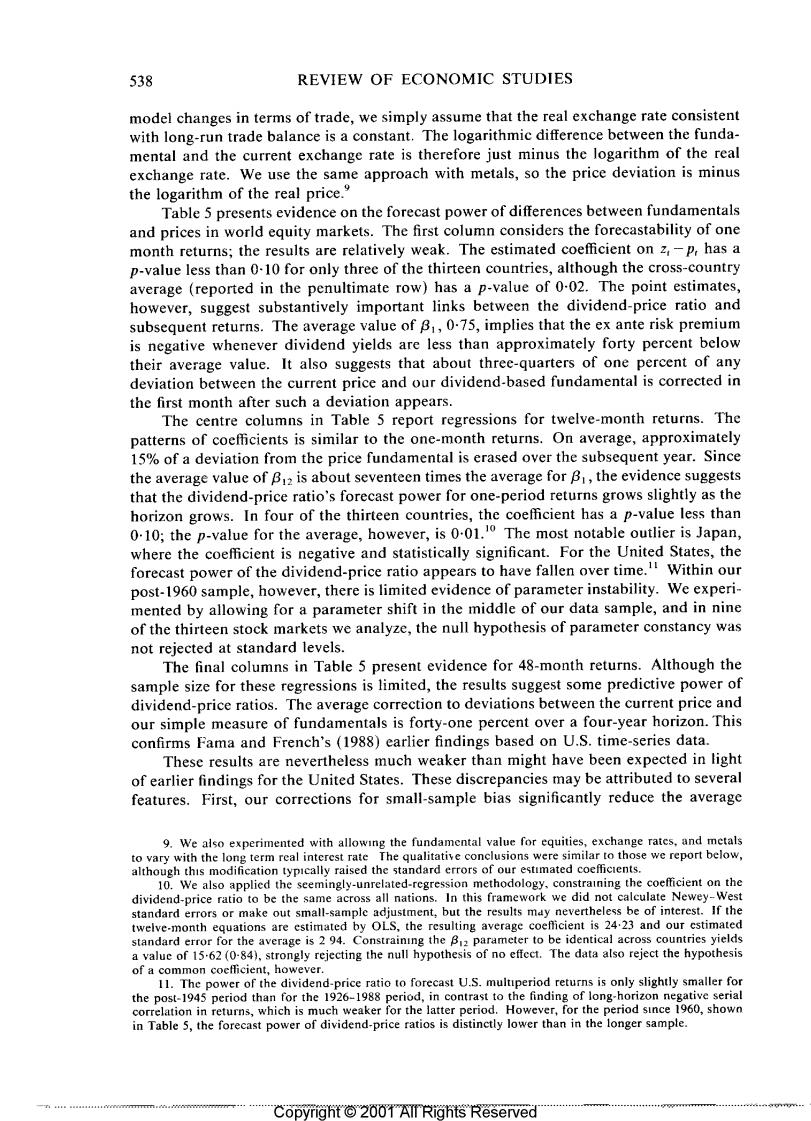正在加载图片...

538 REVIEW OF ECONOMIC STUDIES model changes in terms of trade,we simply assume that the real exchange rate consistent with long-run trade balance is a constant.The logarithmic difference between the funda- mental and the current exchange rate is therefore just minus the logarithm of the real exchange rate.We use the same approach with metals,so the price deviation is minus the logarithm of the real price. Table 5 presents evidence on the forecast power of differences between fundamentals and prices in world equity markets.The first column considers the forecastability of one month returns;the results are relatively weak.The estimated coefficient on z,-p,has a p-value less than 0.10 for only three of the thirteen countries,although the cross-country average (reported in the penultimate row)has a p-value of 0-02.The point estimates, however,suggest substantively important links between the dividend-price ratio and subsequent returns.The average value of B,,0-75,implies that the ex ante risk premium is negative whenever dividend yields are less than approximately forty percent below their average value.It also suggests that about three-quarters of one percent of any deviation between the current price and our dividend-based fundamental is corrected in the first month after such a deviation appears. The centre columns in Table 5 report regressions for twelve-month returns.The patterns of coefficients is similar to the one-month returns.On average,approximately 15%of a deviation from the price fundamental is erased over the subsequent year.Since the average value of B2 is about seventeen times the average for B,the evidence suggests that the dividend-price ratio's forecast power for one-period returns grows slightly as the horizon grows.In four of the thirteen countries,the coefficient has a p-value less than 010;the p-value for the average,however,is 001.The most notable outlier is Japan, where the coefficient is negative and statistically significant.For the United States,the forecast power of the dividend-price ratio appears to have fallen over time.Within our post-1960 sample,however,there is limited evidence of parameter instability.We experi- mented by allowing for a parameter shift in the middle of our data sample,and in nine of the thirteen stock markets we analyze,the null hypothesis of parameter constancy was not rejected at standard levels. The final columns in Table 5 present evidence for 48-month returns.Although the sample size for these regressions is limited,the results suggest some predictive power of dividend-price ratios.The average correction to deviations between the current price and our simple measure of fundamentals is forty-one percent over a four-year horizon.This confirms Fama and French's(1988)earlier findings based on U.S.time-series data. These results are nevertheless much weaker than might have been expected in light of earlier findings for the United States.These discrepancies may be attributed to several features.First,our corrections for small-sample bias significantly reduce the average 9.We also experimented with allowing the fundamental value for equities,exchange rates,and metals to vary with the long term real interest rate The qualitative conclusions were similar to those we report below, although this modification typically raised the standard errors of our estimated coefficients. 10.We also applied the seemingly-unrelated-regression methodology,constraining the coefficient on the dividend-price ratio to be the same across all nations.In this framework we did not calculate Newey-West standard errors or make out small-sample adjustment,but the results may nevertheless be of interest.If the twelve-month equations are estimated by OLS,the resulting average coefficient is 24.23 and our cstimated standard error for the average is 294.Constraining the B2 parameter to be identical across countries yields a value of 15.62(0-84),strongly rejecting the null hypothesis of no effect.The data also reject the hypothesis of a common coefficient,however. 11.The power of the dividend-price ratio to forecast U.S.multiperiod returns is only slightly smaller for the post-1945 period than for the 1926-1988 period,in contrast to the finding of long-horizon negative serial correlation in returns,which is much weaker for the latter period.However,for the period since 1960,shown in Table 5,the forecast power of dividend-price ratios is distinctly lower than in the longer sample. Copyright 2001 All Rights Reserved